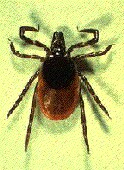- Skip Storing This Everyday Product in the Fridge Door
- Green Tea + B3 Pairing May Boost Brain Health
- Navigating Your Midlife Crisis: Embracing New Possibilities
- City Raccoons Showing Signs of Domestication
- Mapping the Exposome: Science Broadens Focus to Environmental Disease Triggers
- One Week Less on Social Media Linked to Better Mental Health
- Your Brain Changes in Stages as You Age, Study Finds
- Some Suicide Victims Show No Typical Warning Signs, Study Finds
- ByHeart Formula Faces Lawsuits After Babies Sickened With Botulism
- Switch to Vegan Diet Could Cut Your Greenhouse Gas Emissions in Half
Tick Exposure Can Occur in a Minute in Infested Areas


Some areas in the United States have such high tick populations that you can be exposed to the dangerous pests within one minute, an expert warns.
“There are areas in this part of the country that the tick exposure can truly be massive. You can walk into areas and literally encounter dozens or hundreds of ticks,” Michael Dryden, a tick expert and professor of diagnostic medicine and pathobiology at Kansas State University, said in university news release.
These areas generally have conditions that are ideal for ticks: lots of trees and vegetation, a water source, sufficient humidity, and wildlife such as whitetail deer and turkeys.
Avoid such areas if possible, Dryden suggests. If you do go into them, spray insect repellant on the inside of your pant legs, on your socks, ankles and shoes. Roll your pant legs into your socks to reduce the amount of exposed skin. It’s also important to do a daily check of your skin for ticks.
If you find one on your skin, gently lift it with thin forceps or tweezers, and use a magnifying glass to see what you are doing. Your goal is to remove the tick intact.
“Many people believe that ticks fall out of trees,” Dryden said. “They do not do that. What happens is these ticks get on us and they crawl upward until they hit bare skin. The back of the neck is often the first bare skin they find, which leads people to believe they dropped down.”
You also need to protect your pets. Talk to your veterinarian about which tick prevention product is best for your dog or cat.
More information
The U.S. Centers for Disease Control and Prevention has more about ticks.
Source: HealthDay
Copyright © 2025 HealthDay. All rights reserved.










